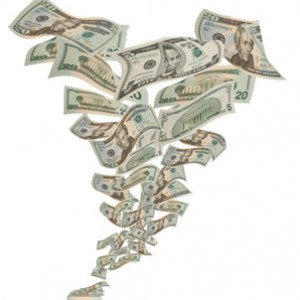 What would happen to your household if it spent $9,000 every single month but only brought in $6,000 every single month? Well, you would quickly accumulate a massive amount of debt that you would very soon not even be able to pay the interest on. You would probably have to end up declaring bankruptcy. So if it is not okay for your household to spend like this, then why is it okay for the U.S. government to do it? On Monday, Barack Obama unveiled his proposed budget for 2011. It calls for 3.83 trillion dollars in spending, and it projects a deficit of 1.3 trillion dollars. In other words, one out of every three dollars that the U.S. government would spend under Obama’s proposed budget would be borrowed.
What would happen to your household if it spent $9,000 every single month but only brought in $6,000 every single month? Well, you would quickly accumulate a massive amount of debt that you would very soon not even be able to pay the interest on. You would probably have to end up declaring bankruptcy. So if it is not okay for your household to spend like this, then why is it okay for the U.S. government to do it? On Monday, Barack Obama unveiled his proposed budget for 2011. It calls for 3.83 trillion dollars in spending, and it projects a deficit of 1.3 trillion dollars. In other words, one out of every three dollars that the U.S. government would spend under Obama’s proposed budget would be borrowed.
In a statement about his proposed budget, Obama warned that we need to start thinking about controlling spending….
“We simply cannot continue to spend as if deficits don’t have consequences.”
That is very true.
We cannot continue to spend as if deficits don’t have very serious consequences.
And yet Obama is doing it anyway.
Not that Bush was much better in this area. Under George W. Bush, federal budget deficits absolutely exploded.
But now Obama is taking things to an entirely new level.
Obama’s proposed budget anticipates $5.08 trillion in deficits over the next 5 years. Those projected deficits are 35 percent higher than the White House projected just 12 months ago.
But the truth is that they are still numbers straight out of fantasyland.
*Obama’s budget projects that the U.S. economy will grow at a 3% rate in 2010, and then will grow by 4.3% in 2011 and 2012.
*Obama’s budget projects a 1% inflation rate in 2010, and inflation rates of less than 2 percent for the rest of the decade.
*Obama’s budget projects that the unemployment rate will remain at 10% in 2010 and then will decline to about 5% by the end of the decade.
So basically the White House expects the U.S. economy to miraculously recover and to grow at a robust pace with super low inflation and super low unemployment for the rest of the decade.
What in the world are they smoking over there?
And even with these incredibly rosy projections, they are still forecasting massive federal deficits for the rest of the decade.
So what if things don’t go so smoothly?
The reality is that the U.S. economy is simply not going to recover. For a comprehensive look at why this is true, please read our previous article entitled “Economic Black Hole: 20 Reasons Why The U.S. Economy Is Dying And Is Simply Not Going To Recover” which goes into great detail about the problems facing our economy.
How bad are the deficits going to be if the U.S. economy really goes down the tubes?
That is such a frightening scenario that it is hard to even think about it.
Meanwhile, the watchdog in charge of monitoring the U.S. government’s $700 billion bailout program says that TARP is simply not working.
In his recent quarterly report to Congress, special inspector general Neil Barofsky said that TARP has basically completely failed to boost bank lending and has basically completely failed to halt the spread of foreclosures.
So why did we spend all that money if it isn’t doing any good?
After all, Obama promised that if we helped out Wall Street, they in turn would be more than happy to help out “Main Street”.
But a funny thing happened.
The banks decided to hoard the cash.
In fact, the Treasury Department reported earlier this month that the 22 banks that got the most aid from the government’s various bailout programs have cut their small business loan balances by $12.5 billion since April.
So they are not even lending as much money as they used to.
Ouch.
It seems that very little of what the U.S. government is trying to do is working these days.
But at this point there is not much that can be done.
As far as the economy goes, there are basically two choices.
#1) The U.S. government could try to cut spending and balance the budget, but that would cripple the economy and it would potentially send unemployment soaring to Great Depression levels. The U.S. would experience a deflationary depression that could take decades to recover from.
#2) The U.S. government could try to stimulate the U.S. economy by borrowing even more money than before and by cranking up the debt spiral that our financial system is based on one more time. Of course this could very well result in the complete destruction of the dollar and the complete destruction of our financial system, but it is the choice that would keep life in the U.S. somewhat “normal” at least for now. This is essentially the choice that the Obama administration and the Federal Reserve have chosen.
Because of the gigantic mountain of debt that our society has accumulated, there really are no other alternatives. We can try to put off the inevitable for a while, but the truth is that we will either be facing a deflationary depression or a hyperinflationary nightmare in the years ahead.
All indications are that the Obama administration and the Federal Reserve are pursuing policies that will lead to a hyperinflationary nightmare. They are hoping that all of this government borrowing can crank up the debt spiral the U.S. economy is based on one more time. But ultimately this is only going to lead to hyperinflation and the destruction of the dollar.
When a loaf of bread costs ten dollars a whole lot of people are going to be really pissed off, but it isn’t as if many of us haven’t been trying to warn you.
It simply was not realistic for the American people to pile up the biggest mountain of debt in the history of the world and to think that there would not be very serious consequences.
There are going to be very, very serious consequences.
We did this to ourselves and the fallout is going to be very, very painful.
